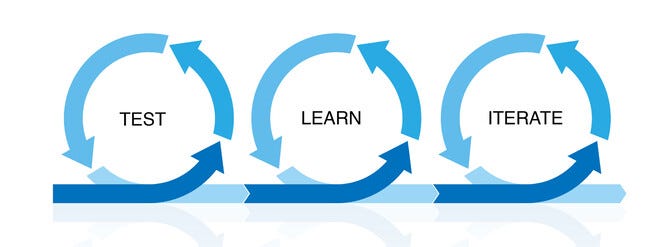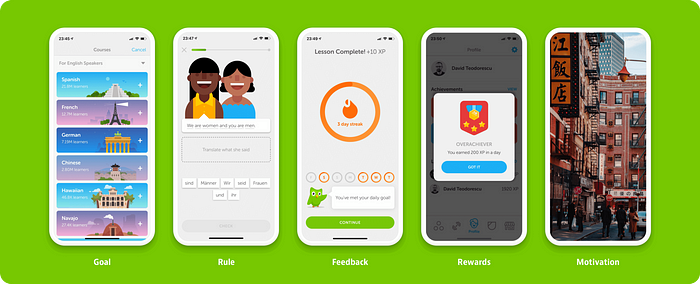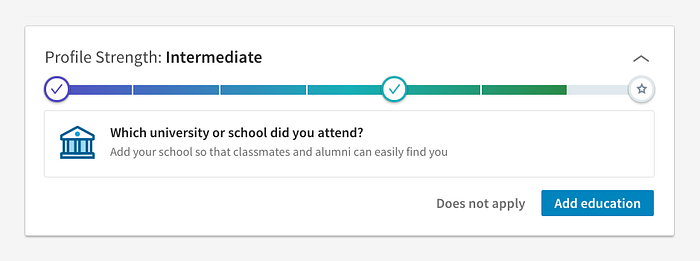

Gamification in Product Design (UI/UX)
source link: https://uxplanet.org/gamification-in-product-design-ui-ux-14047dc6ccab
Go to the source link to view the article. You can view the picture content, updated content and better typesetting reading experience. If the link is broken, please click the button below to view the snapshot at that time.
Gamification in Product Design (UI/UX)
“Games are nature’s most beautiful creation.”
— Leonard Cohen
Gamification empowers UX design by tapping into human behaviour and emotions, executed correctly it levels up user engagement and increases the chances of the product becoming a huge success. Although gamification has become a bit of a buzzword of late, its basic principles have been around for centuries.
For example, what’s a technique that parents have used for generations for their children to eat their food? To make a game out of it! Either by pretending the spoon is an aeroplane landing and taking off, or even by using a reward such as a dessert.

“Gamification is both powerful and flexible — it can readily be applied to any problem that can be solved through influencing human motivation and behavior.”
– Christopher Cunningham and Gabe Zichermann
In this blog post, we will talk about gamification, specifically its role in UI/UX design. Briefly covering best techniques, with some real-world examples for context.
What is Gamification?
“Gamification is the process of using game design concepts to engage users in ways that aren’t traditionally considered game environments.”
– Ross Unger and Carolyn Chandler, A Project Guide to UX Design
Gamification is simply using mechanics or elements of games in non-game settings. Usually fun mechanics such as challenges, levels, rewards and badges — more on this later. It is not about designing and building a full-fledged game, it is literally applying elements that tend to be used for games in the design. As Brian Burke puts it in his book Gamify. “Games primarily engage players on a whimsical level to entertain them…Gamification engages players on an emotional level to motivate them.”
Here are a few examples of real-world activities in which gamification has been successful:
🏆 A monthly sales competition at work (challenge)
🏆 Frequent-flier program tiers (levels)
🏆 Weight Watchers group (team)
🏆 Free coffee after 12 purchases (reward)
🏆 American Express platinum card (badge)
There are many examples, especially in the last few years where we’ve seen gamification experimented with in all sorts of sectors. Interestingly Volkwagen created an initiative called the “Fun Theory” where they tested gamification techniques in the real world. In Sweden, they implemented it with speed cameras, straightforwardly titled the Speed Camera Lottery. In a nutshell, the experiment put all drivers passing the speed camera into a lottery, drivers who obeyed the speed limit would be entered into the lottery, where they’d be eligible to win the money from the speeder’s fine. This addition of fun through competition and reward resulted in a 20% speed reduction!
Another successful gamification project was titled the Piano Staircase, which essentially transformed a plain staircase into a music-playing piano. This experiment was created to find out if more people would use the stairs over the escalator. The result, 66% more people took the stairs!

Gamification techniques have become super popular recently in UI/UX Design, and for good reason. It’s now become an essential component to many great products, products ranging from language-learning platforms, to healthcare and fitness and even digital banking. It makes perfect sense why gamification is so popular and successful. “Our brains are wired to crave puzzle solving, feedback and reinforcement, and the other experiences that games provide. Study after study has shown that games activate the brain’s dopamine system, which is associated with pleasure” (Kevin Werbach).
To get a better idea, here is a list of several popular mechanics:
⭐ Achievements
⭐ Avatars
⭐ Badges
⭐ Challenges
⭐ Coins (internal currency)
⭐ Competition
⭐ Leaderboards
⭐ Levels
⭐ Points
⭐ Progress (feedback)
⭐ Rewards
There are several others, however, we find these to be the most useful and more relevant to UX Design. However there are others as detailed by researchers at the University of Limerick in Ireland: collections, combat and boss fights, content unlocking, gifting, quests, social graphs, teams, virtual goods, infinite gameplay, search and discovery, time constraints and negative scoring.
Getting it right, the challenge of gamification
However, gamification is a complex subject, and not all elements of gamification are successful. It’s not simply just about slapping on some avatars, badges and leaderboards and hoping it will work. Paraphrasing Jesse Schell in his talk. Gamification is a bit like chocolate, it makes a lot of things taste better. But not everything. And having the knowledge of what works, on what, and when is the key. Jesse humorously calls adding chocolate to everything “chocification.”
Furthermore, every gamification mechanic is different, some can be more relevant than others. A good example of this is leaderboards. Leaderboards in some scenarios may actually discourage a user as they can be demotivating, especially if the top places are incredibly out of reach. Duolingo interestingly has leaderboards as an optional, you can toggle it on or off depending on if you want to participate. Another example as mentioned in the book For the Win is badges. Redding Record Searchlight’snewslettersubscriptions actually decreased after the introduction of a “deal finder” badge system.
“Game thinking asks a different question: Why do people buy your product or use your service in the first place? And it asks it in a particular way: What is their motivation? What makes your customers want to do business with you? And once you know this, game thinking asks: Can you make it more compelling, more interesting, and more fun?”
Gamification is not a cookie-cutter solution, it must be the right fit for the product, and it must meet the business needs and objectives. A simple example, gamification for a funeral business most probably would not be the right fit. Also adding game mechanics to solve fundamental and core business problems might not work either, for example, it can’t just magically heal years of shambolic customer service. This is why it’s paramount to understand the business and user needs before adding gamification techniques, you must understand the why before you go all out on confetti. Once you know what your users want (the why) and the goals you want to achieve then gamification techniques might be useful. You can gradually start introducing them with rapid testing and iterating. “Unlike video games, gamified solutions should evolve over time to add new functionality, to engage the audience in new ways, and to keep them fresh.” (Brian Burke).

In the book Gamify Brian Burke explains the three primary reasons why gamified solutions usually fail:
- “The business outcomes haven’t been clearly defined.
- The gamified solution has been designed to achieve the organizational goals rather than the player goals.
- The solution engages people on a transactional level rather than an emotional level.
…successful gamification is a process of composing an engaging experience for a target audience. Plan to spend considerable time gaining a real understanding of the players and their motivations and goals.”
At the end of the day game design and gamification is hard, even companies like EA and Sony have spent millions on games that have just simply flopped. However, through research, testing and iterating (as we spoke about before) your chances of success increase drastically.
Below is a solid strategy to implement gamification, as described in the Gamification Toolkit:
“Gamification is best implemented in six steps, each of which starts — like the word “design” — with the letter D:
1. DEFINE business objectives.
2. DELINEATE target behaviors.
3. DESCRIBE your players.
4. DEVISE activity cycles.
5. DON’T forget the fun!
6. DEPLOY the appropriate tools.”
“It shouldn’t come as a surprise to see that fun motivates people. Gamification is the process of manipulating fun to serve real-world objectives.”
— Kevin Werbach
Bonus tip
Gamification by Design puts it brilliantly. When designing for gamification instead of thinking about your user or customer “instead use the word ‘player’ from this point forward. By thinking of our clients as players, we shift our frame of mind toward their engagement with our products”.
Gamification examples
Duolingo
Duolingo the education-learning app has become a great success, with over 37 million active users. Aesthetically it is super fun looking, which is a complete contrast to other language-learning platforms in the past. It has also leveraged pretty much all of the mechanics mentioned above. “Duolingo encourages players to learn languages using a slew of gamification techniques, like points, achievements, leaderboards, strong feedback loops, content unlocking, and social engagement. ”… “Its success, by now, is obvious — it offers 94 different language courses in 23 languages, has over 300 million registered users” (Kevin Werbach).

Even LinkedIn a platform for recruitment (which isn’t the most indicative of fun) has used gamification. In a style of a progress bar and badges, to entice a user to complete their profile so that they would be more likely to attract a hirer. It was incredibly successful, LinkedIn was able to boost the rate of completed profiles up to 55%.

FitBit
FitBit is another great example, an app which popularised the idea of walking 10,000 steps a day. It’s been a great success in getting people to exercise more, mostly due to it’s gamification mechanics. Fitbit’s app tracks your activity and applies a score to it, the app gives you daily challenges, rewards you with badges, and even lets you compete with friends by showcasing the super visual leaderboards. Nike+ and Zombie Run are two other great examples of popularising fitness via gamification.

These mechanics tend to be super visual, however, gamification can also be used in a more subtle approach. It can be a deeper pattern that deeply changes behaviour, such as unpredictable or variable rewards, or by adding disguised or inconspicuous competition.
For example, an infinite scrolling feed, as seen on popular apps like Instagram, Pinterest and TikTok. These feeds keep users hooked by having unpredictable rewards, never knowing what the next scroll will show. This uncertainty of never knowing when the next payoff will be, keeps the user hooked. This is similar to the most popular activity in a casino, slot machines. It’s easy to keep playing when you think at any time you could get a reward, even after countless hours of playing, you still have a glimmer of hope that the next one will be the jackpot, or maybe the one after.
Competition is also obvious in social media platforms when trying to level up your score by increasing your following, likes or even reposts (this can be seen whenever design tries to quantify something). You’re motivated to keep your score up, or even improve from the previous one.
“Players get a dopamine surge when it happens, a little like hitting a jackpot on a slot machine. This mechanism is called a “variable reward schedule.”
– Kevin Werbach
There are hundreds of examples, but hopefully this gives you a solid idea of what gamification is, and how it has been applied in UI/UX Design.
Conclusion
To wrap up. It’s clear to see why gamification mechanics have become super popular in UI/UX Design, these fun and engaging techniques clearly work, granted it’s executed correctly. Gamified solutions are about rethinking motivation in a time where we’re more and more connected digitally than physically. It’s about building motivation into a digitally engaged world, and we are just getting started in this journey.
By 2025 three out of four workers will be millennials, many of which have grown up with video games all around them. As digital natives, some of these features may even be expected as there’s a higher need for being constantly engaged, and having experiences tailored for us. This further highlights the importance of adding gamification elements to your product to make sure it’s future-proof. Especially with the maturation of emerging technologies that will seamlessly be integrated into our daily lives, such as gesture controls and AR, all of which are inherently game-like. Like it or not, gamification is here to stay, game-like techniques have been used to engage and motivate people to reach their goals since, well forever. Just like chocolate, it will continue bringing joy to most people's lives.
“Fun is the act of mastering a problem mentally”
— Ralph Koster, A Theory of Fun
As always we would love to hear your thoughts, do let us know in the comments below if you have any questions or want to know more!
Would you like to work with us? We are a friendly bunch, come and say hi 👋
Much ❤️ 🧡 💛 💚
Recommend
About Joyk
Aggregate valuable and interesting links.
Joyk means Joy of geeK